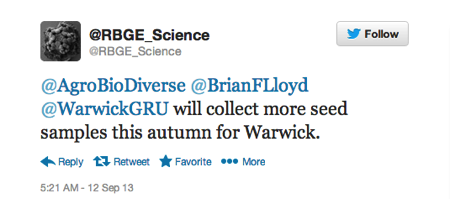Speaking of social media, Royal Botanic Gardens Edinburgh just published an interesting post entitled Botanic gardens conserve crop diversity too. 1 The crux of the matter is that RBGE tweeted about having collected some wild relatives of cabbages and other veg. A picture of one cabbage caught Luigi’s eye, as pictures of wild relatives often will, and he in turn discovered that the population from which it came is not represented in the UK’s leading collection at the Genetic Resources Unit in Warwick. Horrors! As he said at the time:
[T]he material mentioned in the Edinburgh tweet, which comes from Fife in Scotland, is likely to add significant diversity to the “national” collection at Warwick. Scope for some closer collaboration between these two institutes? Well, maybe it’s already there and I haven’t caught it. Do let me know if I’m being unfair.
@RBGE_Science shot back a tweet.

Fast forward less than a week, and RBGE now has this to say:
Seed samples from wild collections … will be passed to the Genetic Resources Unit at Warwick to enhance their CWR collection. An example of the value of this collaboration is provided by the fact that Warwick currently has no Scottish origin wild cabbage. … [T]his in turn will provide further ex-situ conservation for what is quite a rare plant in Scotland.
Was Luigi being unfair? Or should he take full credit for furthering cross-border collaboration in the important matter of cabbage wild relatives?
The RBGE has (good) form on CWRs. A staff member, George Argent, was a wild Musa specialist 35 years ago.
Argent GCG.1976. The wild bananas of Papua New Guinea. Notes from the Royal Botanic Garden Edinburgh 35:77-114.
Presumably his collections are being grown somewhere. Or are they? Anybody know?
I don’t know whether George Argent collected and shared seeds or suckers with the RBGE or anyone else. The ITC in Belgium has a few accessions of wild banana species collected in PNG in the late 1980s, which they keep as in vitro plants. The NARI banana collection in Laloki near Port Moresby had field duplicates, but they have since lost them. As far as I know, it currently has only one wild species in its collection, but then again it’s not the best place to grow wild bananas as it is a relatively dry area.
Thanks. But didn’t Laloki get an irrigation system? Here’s the text of a tweet from RBGE:
@RBGE_Science: @AgroBioDiverse @promusa_banana Musa gracilis M. violascens 1995; Musa monticola 1989; Musa johnsii 2001 all collected by George Argent.
Yes, but that was after they had lost the accessions.